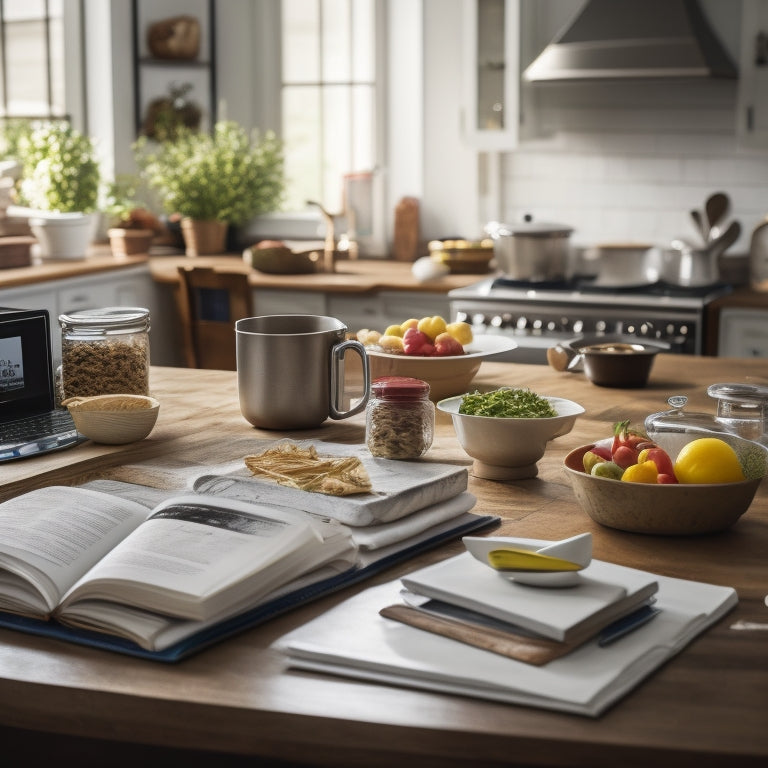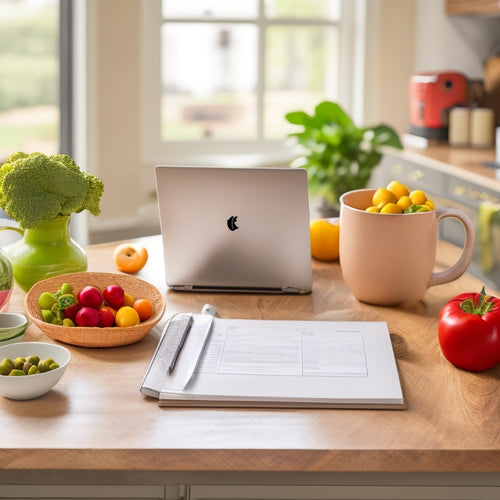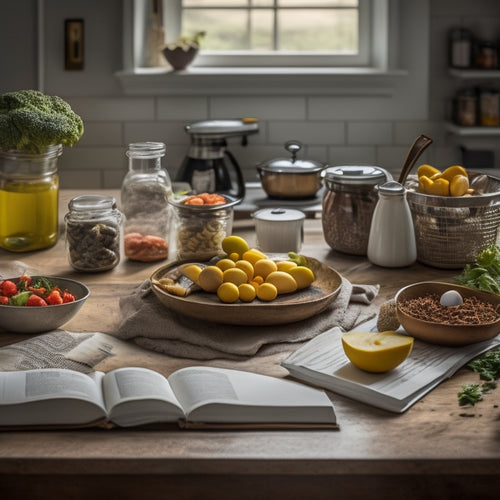
Why Cooking Courses Need Meal Planning Templates
Share
You're likely no stranger to the chaos that can erupt in the kitchen when cooking for a crowd, which is precisely why incorporating meal planning templates into your cooking course is a game-changer. By implementing templates, you'll streamline kitchen operations, reduce food waste, and save time and money. You'll simplify meal prep, organize recipes, and maximize ingredients' potential. Templates will also help you eliminate last-minute stress, think creatively, and achieve consistency and quality. With a solid meal planning system in place, you'll be able to focus on what really matters - cooking up a storm! Now, let's delve into the nitty-gritty details of how to make it happen.
Key Takeaways
• Meal planning templates streamline kitchen operations, reducing chaos and increasing productivity in cooking courses.
• Templates help reduce food waste by planning meals around seasonal ingredients and pantry staples, promoting sustainable consumption.
• By using meal planning templates, cooking courses can save time and money by slashing grocery bills and avoiding last-minute takeouts.
• Templates simplify meal preparation by streamlining grocery lists, prioritizing key items, and categorizing lists for efficient shopping.
• Meal planning templates enable cooking courses to enhance culinary creativity and freedom by shifting focus from rigid recipes to exploring new flavors.
Streamlining Kitchen Operations
Optimize your kitchen workflow by implementing a few simple strategies to streamline kitchen operations, saving you time and reducing meal prep stress.
You can start by establishing a clear kitchen hierarchy, defining roles and responsibilities to avoid confusion and overlapping tasks. This will help you delegate tasks efficiently and maintain a smooth flow of operations.
Next, create operational flowcharts to visualize your kitchen workflow, identifying areas that need improvement and opportunities for optimization. These visual aids will help you pinpoint bottlenecks and make data-driven decisions to enhance your kitchen's productivity.
By streamlining your kitchen operations, you'll be able to cook meals more efficiently, reduce stress, and enjoy the cooking process. With a well-organized kitchen, you'll have more time to focus on what matters – creating delicious meals and enjoying quality time with loved ones.
Reducing Food Waste Effectively
By planning your meals around seasonal ingredients and pantry staples, you can significantly reduce food waste and save money on your grocery bills. This approach guarantees that you're using up fresh produce before it goes bad and making the most of your pantry items. As a result, you'll be contributing to a more sustainable consumption pattern, which is essential for our planet's well-being.
Food recovery is another important aspect of reducing food waste. By planning your meals, you can identify opportunities to repurpose leftovers, turning them into new, exciting dishes. This not only reduces waste but also gets creative juices flowing in the kitchen.
Additionally, meal planning helps you avoid buying unnecessary items, which often end up in the trash. By being more intentional with your food choices, you're taking a significant step towards a more sustainable future.
With a meal planning template, you'll have the tools to make a positive impact on the environment while enjoying delicious, home-cooked meals.
Saving Time and Money
You can slash your grocery bills and free up hours in your week by implementing a meal planning strategy that streamlines your cooking routine. By having a clear plan, you'll avoid last-minute takeouts and reduce impulse buys, saving you money and time.
With a meal planning template, you'll be able to track your budget and stay on top of your financial goals. You'll know exactly how much you're spending on groceries and can adjust your plan accordingly.
Simplifying Meal Preparation Process
When you simplify your meal preparation process, you'll find that you're saving time and reducing stress in the kitchen. By implementing a few key strategies, you'll be able to create a more efficient workflow that gets you from prep to plate in no time.
In this section, we'll explore two essential points: streamlined grocery lists and efficient kitchen workflow, which will help you achieve a more streamlined cooking routine.
Streamlined Grocery Lists
With a meal planning template, your grocery list takes shape, ensuring that every essential ingredient is accounted for and excess items are eliminated. This streamlined approach helps you avoid impulse buys, reducing food waste and saving you money on your grocery budgeting.
By prioritizing your list, you'll focus on the key items, making sure you don't forget important components. You'll also avoid overbuying, which can lead to cluttered pantries and spoiled food.
With your template, you can categorize your list by aisle or store section, making your shopping trip more efficient. You'll zip through the store, checking off items with confidence.
This organized approach also helps you identify areas where you can cut costs, making adjustments to your grocery budgeting strategy as needed. By streamlining your grocery list, you'll save time, reduce stress, and enjoy a more liberated cooking experience.
You'll be free to focus on the joy of cooking, rather than getting bogged down in meal prep chaos.
Efficient Kitchen Workflow
Two hours of meal prep can be condensed into 30 minutes of focused activity by implementing an efficient kitchen workflow that streamlines meal preparation. You can achieve this by establishing a clear Kitchen Hierarchy, where each task is prioritized based on importance and urgency. This allows you to tackle the most critical tasks first, making sure that your meal prep stays on track.
Next, optimize your Workstation Layout to minimize movement and maximize productivity. Designate specific areas for chopping, cooking, and plating, and make certain that all necessary tools and ingredients are within easy reach. This will save you time and energy, allowing you to focus on the task at hand.
Organizing Recipes Efficiently
How do you currently store and categorize your recipes, and are you able to quickly find the one you need when meal planning? If you're like most cooks, you probably have a collection of recipe books, printouts, and notes scattered around your kitchen.
But when it comes to meal planning, you waste precious time searching for that one recipe you know you have somewhere.
It's time to get organized and liberate yourself from recipe chaos! Implementing a solid recipe categorization system is key. Create digital folders or files labeled by course, ingredient, or cooking method, and store your recipes in a cloud-based platform or note-taking app.
This way, you can access your recipes from any device and easily search for specific dishes. Digital archiving also allows you to tag and rate your recipes, making it easier to identify your favorites and plan meals around them.
With a well-organized recipe collection, you'll save time, reduce stress, and enjoy the cooking process more. Take control of your recipes and start cooking with confidence!
Mastering Kitchen Management Skills
When you're cooking, you're not just preparing a meal - you're managing a kitchen. To master kitchen management skills, you'll want to focus on organizing your station, streamlining prep work, and maintaining an efficient recipe flow.
Organize Your Station
You'll save time and reduce stress by designating a specific spot for frequently used ingredients and utensils, creating a well-organized station that streamlines your cooking process. A clean workspace is essential for efficient cooking, and a well-set-up station helps you stay focused on the task at hand.
Here's a simple way to organize your station:
| Zone | Items | Benefits |
|---|---|---|
| Prep Zone | Cutting board, knives, utensils | Quickly access tools for prep work |
| Cooking Zone | Pots, pans, cooking utensils | Efficiently cook and manage dishes |
| Ingredient Zone | Frequently used ingredients, spices | Easily access ingredients, reducing clutter |
Streamline Prep Work
With your station organized, now it's time to tackle the prep work, where a few simple strategies can make a big difference in your overall cooking efficiency. You'll be amazed at how much faster you can prep ingredients when you have a system in place.
Start by prioritizing tasks based on the recipe's requirements. Chop ingredients that can be used in multiple dishes first, and consider prepping ingredients that require similar techniques, like dicing or slicing, at the same time. This will save you time and reduce waste. Don't forget to follow proper Food Safety guidelines when prepping, like washing your hands and utensils frequently and keeping raw meat separate from ready-to-eat foods.
One of the most effective Kitchen Hacks for prep work is to prep in bulk. Chop a whole onion instead of just what you need for the recipe, and store the excess in an airtight container for future meals.
Efficient Recipe Flow
To master efficient recipe flow, organize your recipes into a logical sequence of tasks, guaranteeing that each step builds upon the previous one to minimize downtime and maximize productivity. This means considering the recipe timing and course structure to guarantee a seamless cooking experience. By doing so, you'll be able to prep, cook, and serve dishes without any hiccups.
Here are three key takeaways to help you achieve efficient recipe flow:
-
Prioritize tasks based on cooking time: Identify the dishes that take the longest to cook and start with those first. This guarantees that everything is ready to be served at the same time.
-
Group similar tasks together: Combine tasks that require similar cooking techniques or ingredients to minimize switching between stations and reduce waste.
-
Leave buffers for flexibility: Build in some extra time between tasks to account for any unexpected delays or setbacks.
Maximizing Ingredients Potential
By strategically planning your meals around a core set of ingredients, you can harness a variety of dishes while minimizing food waste and saving time. This approach allows you to utilize the full potential of each ingredient, ensuring that every item in your pantry or fridge is used to its fullest extent.
When you focus on a few key ingredients, you can create a range of dishes that showcase their fresh flavor and ingredient synergy. For instance, a single bunch of fresh herbs can be used to enhance flavor in soups, salads, and sauces. Similarly, a bag of rice can be transformed into a variety of dishes, from stir-fries to curries.
Eliminating Last-Minute Stress
When you're cooking a meal, the last thing you want is to feel frazzled and stressed. By planning ahead effectively, you'll avoid those frantic moments of uncertainty and save time in the long run.
Plan Ahead Effectively
You can greatly reduce last-minute stress by dedicating just 30 minutes each week to planning your meals, making grocery lists, and scheduling cooking time. This small investment of time will pay off in a big way, allowing you to feel more in control and prepared for the week ahead.
Here are three simple steps to help you plan ahead effectively:
-
Create a Culinary Calendar: Set up a calendar specifically for meal planning, where you can schedule out your meals for the week. This will help you visualize your meals and make adjustments as needed.
-
Block Time for Cooking: Schedule time blocks in your calendar for cooking and prep work, ensuring you have enough time to get everything done.
-
Prioritize Your Time: Identify the most time-consuming tasks, such as meal prep or cooking complex recipes, and tackle them first. This will help you stay on track and avoid last-minute stress.
Simplify Grocery Lists
Streamline your grocery shopping process by organizing your list into categories, such as produce, meats, dairy, and pantry staples, to make sure you don't forget anything essential. This approach helps you prioritize your list, ensuring you're not missing critical items. By grouping similar items together, you'll reduce the likelihood of impulse purchases, which can blow your grocery budget.
When creating your list, prioritize items based on your meal plan and the number of meals you're planning to cook. This helps you focus on the most critical ingredients and avoid buying unnecessary items. Consider your grocery budgeting goals and allocate your funds accordingly. Allocate a specific amount for each category to prevent overspending.
Reduce Kitchen Chaos
Reduce Kitchen Chaos
Organizing your kitchen workspace beforehand helps to reduce last-minute stress, allowing you to efficiently prep ingredients and cook meals according to your plan. You'll be amazed at how a clutter-free kitchen can clear your mind and make cooking a breeze.
With a meal planning template, you can plan your meals, make a grocery list, and prep your ingredients in advance. This sets you up for success, giving you the culinary peace of mind you deserve.
Here are three kitchen hacks to reduce chaos:
-
Designate a prep zone: Set aside a specific area for prepping ingredients, and keep all necessary tools and utensils within reach.
-
Label and categorize: Label your storage containers and categorize your ingredients to make sure you can find what you need quickly.
-
Clean as you go: Clean up as you cook to avoid a massive cleanup at the end of the meal.
Enhancing Culinary Creativity Freedom
How can you liberate yourself from the constraints of traditional recipes and unlock your full culinary potential? With meal planning templates, you can shift your focus from following rigid recipes to exploring new flavor profiles and culinary expressions. This freedom allows you to experiment with different ingredients, cooking techniques, and presentation styles, giving you the creative license to craft dishes that truly reflect your personality.
By having a template to guide your meal planning, you can devote more time to thinking about the flavors, textures, and aromas you want to combine. You can start to think outside the box, substituting ingredients, and trying new cooking methods. This, in turn, enables you to develop your unique culinary voice, making every dish a reflection of your artistry.
With meal planning templates, you're no longer bound by the limitations of traditional recipes. You're free to push the boundaries of flavor, texture, and presentation, creating dishes that are truly original and innovative. So, don't be afraid to get creative, to take risks, and to make mistakes. That's where the magic happens, and that's where your culinary expression truly comes alive.
Achieving Consistency and Quality
As you explore the world of culinary creativity, you'll find that meal planning templates also help you establish a consistent level of quality in your dishes. Consistency is key to building trust with your customers or family, and meal planning templates guarantee that your dishes meet your brand standards every time.
Here are three ways meal planning templates help you achieve consistency and quality:
-
Standardized Recipes:
With meal planning templates, you can standardize your recipes, ensuring that every dish is made with the same ingredients and techniques. This eliminates variations that can impact the quality of your dishes. -
Quality Control:
Meal planning templates help you implement quality control measures, such as checking for ingredient freshness and cooking techniques. This guarantees that your dishes meet your quality standards every time. -
Batch Cooking:
Meal planning templates allow you to plan and prepare ingredients in bulk, reducing waste and ensuring that you're using the freshest ingredients. This results in consistent, high-quality dishes that meet your brand standards.
Frequently Asked Questions
Can I Customize Meal Planning Templates to Fit My Personal Diet?
You can definitely customize meal planning templates to fit your personal diet! Simply adjust the templates to reflect your personal preferences and dietary goals, and you'll have a tailored plan that liberates you from mealtime stress.
Are Meal Planning Templates Suitable for Special Dietary Needs?
You'll find that meal planning templates are indeed suitable for special dietary needs, as they allow for dietitian input and precise nutritional analysis, ensuring you can tailor plans to your unique requirements with confidence and flexibility.
Can I Use Meal Planning Templates for Large Group Cooking?
You're juggling multiple dishes like a circus performer, but can you scale up meal planning templates for large group cooking? Absolutely! They're perfect for catering events, allowing you to bulk shop and organize meals with ease, freeing you to focus on the fun stuff.
Do Meal Planning Templates Account for Food Allergies and Intolerances?
You'll find that many meal planning templates do account for food allergies and intolerances through labeling systems and allergy alerts, ensuring you can easily identify and accommodate special dietary needs.
Are Meal Planning Templates Available in Digital and Printable Formats?
"It's a coincidence you're looking for flexibility in meal planning! You'll find templates in both digital and printable formats, catering to your format preferences and providing accessibility options, ensuring you stay on top of your meal planning game."
Related Posts
-

Free Low-Carb Meal Planning Templates for Easy Success
You're about to discover the secret to effortless low-carb meal planning: leveraging free, customizable templates tha...
-

Why Keto Dieters Need a Meal Planning System
You need a meal planning system to supercharge your keto diet because without one, you'll be stuck in a vicious cycle...

